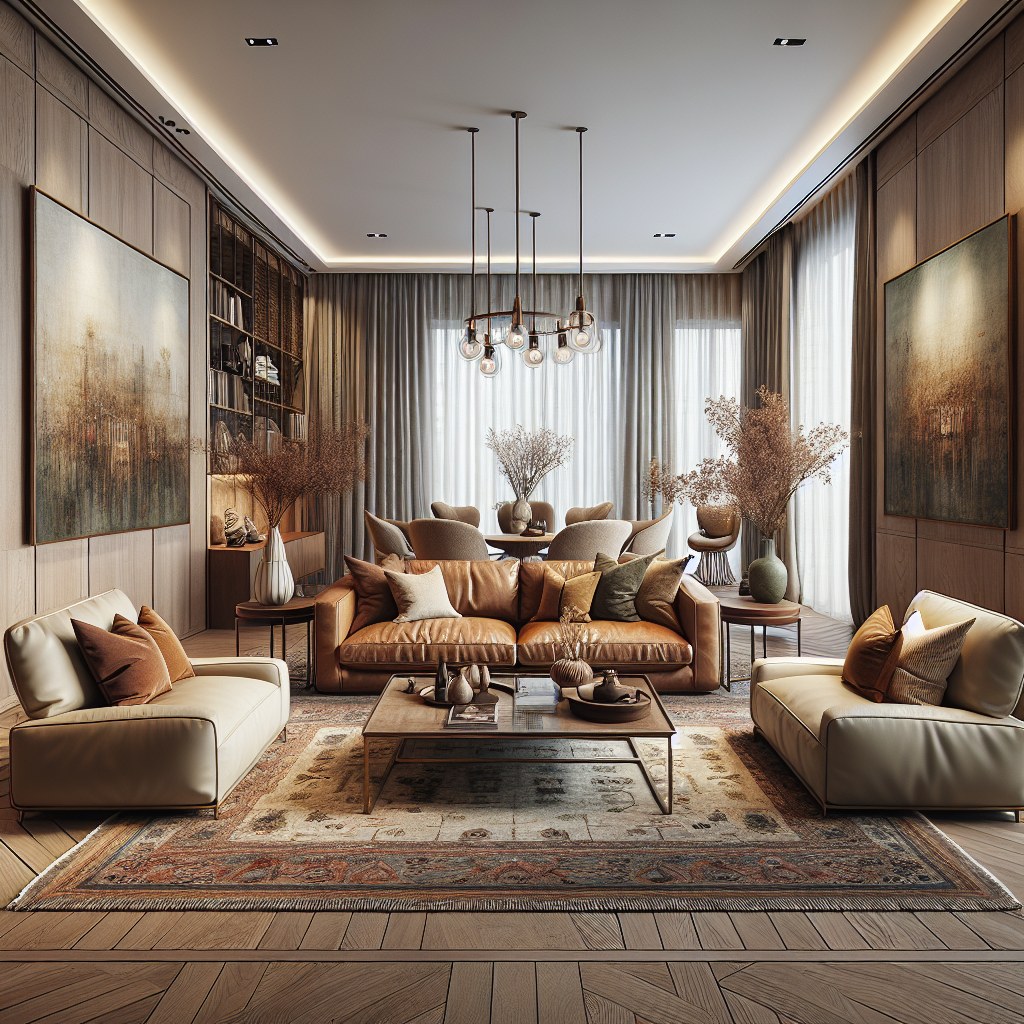Looking to create two seating areas in one living room? Here’s how to maximize your space for functionality and style.
By strategically arranging your furniture, you can create a cohesive seating arrangement that allows for multiple activities in the same space. Whether it’s a cozy reading nook and a conversational seating area or a formal entertaining space and a casual lounge, there are various design options to consider.
With the right furniture placement, you can achieve a balanced and inviting living room that meets your lifestyle needs. This article will explore different layout ideas, furniture selection tips, and decor elements to help you make the most of your dual seating areas. Let’s dive in and discover how to design a multi-functional and visually appealing living room with two distinct seating zones.
Maximizing Space In A Living Room
When it comes to maximizing space in a living room, one clever and efficient solution is to create two seating areas. This not only adds versatility to the room but also allows for multiple activities to take place simultaneously. In this blog post, we will explore the design considerations for dual-function seating areas and the benefits they bring to your living space.
Designing For Dual Functions
Designing a living room with two seating areas requires careful planning and consideration of the available space. Here are some key points to keep in mind:
- Create separate zones: Divide the room into distinct zones using furniture placement, rugs, or room dividers. This ensures each seating area has its own defined space.
- Consider traffic flow: Ensure there is enough room for people to move comfortably between the two seating areas and around the room.
- Utilize multifunctional furniture: Opt for furniture pieces that serve multiple purposes, such as ottomans with hidden storage or a coffee table that can be easily transformed into a dining table.
- Focus on proportion and scale: Maintain a balanced look by choosing furniture and accessories that are appropriately sized for the space. Avoid overcrowding one area while leaving the other feeling empty.
Benefits Of Two Seating Areas
Having two seating areas in your living room offers several advantages:
- Increased functionality: With separate seating areas, you can accommodate different activities simultaneously. For example, one area can be dedicated to conversation and relaxation, while the other serves as a workspace or a place for kids to play.
- Improved social interaction: The presence of two seating areas encourages socializing, as it allows guests to split into smaller groups and engage in more intimate conversations.
- Enhanced visual interest: Creating two distinct seating areas adds visual depth and interest to your living room. It breaks up the space and adds a layered look that is visually appealing.
- Flexible arrangement: Dual seating areas provide flexibility in arranging furniture. You can rearrange the layout based on your needs or when hosting larger gatherings.
Credit: maidenhome.com
Creating Distinct Zones
Creating distinct zones in a living room with two seating areas allows for separate spaces that cater to different activities and preferences, enhancing both functionality and aesthetics.
“`html
Creating Distinct Zones
“`
When it comes to a living room with two seating areas, creating distinct zones is essential to maximize the functionality and aesthetics of the space. By strategically differentiating each area through furniture placement, color, and texture, you can achieve a harmonious and well-organized living room.
“`html
Furniture Placement
“`
In a living room with two seating areas, the proper placement of furniture plays a crucial role in delineating distinct zones. Position sofas and chairs in a way that defines each seating area, creating a clear separation between the two spaces. Utilize area rugs to visually separate the zones further, providing a designated space for each seating area.
“`html
Color And Texture Differentiation
“`
When it comes to color and texture, utilizing different elements for each seating area can help establish clear boundaries between the zones. Consider incorporating bold and distinctive colors for one area and a complementary, muted palette for the other. Use a variety of textures, such as leather, fabric, or woven materials, to add visual interest and uniqueness to each seating space.
By implementing these strategies, you can effectively transform a single living room into an inviting and functional space with two distinct seating areas.
Choosing The Right Furniture
When it comes to creating two seating areas in one living room, choosing the right furniture is crucial. The selection of sofas, sectionals, chairs, and ottomans plays a vital role in defining the layout and functionality of the space. Let’s dive into the key considerations for each furniture category.
Sofas And Sectionals
Selecting the appropriate sofas and sectionals is essential to establish distinct seating zones. Consider the size and style of the room to determine whether a large sectional or a couple of sofas would be more suitable. It’s important to measure the space accurately to ensure the selected furniture pieces fit harmoniously within the designated areas. Moreover, opting for versatile designs with reversible chaise or modular features can provide flexibility in arranging the seating layout.
Chairs And Ottomans
Chairs and ottomans are instrumental in adding depth and character to the dual seating concept. Incorporating accent chairs in contrasting colors or patterns can infuse visual interest and individuality to each seating zone. Additionally, utilizing ottomans as multifunctional pieces can offer flexibility in creating intimate conversation corners within the living room. Pay attention to ergonomic aspects and select seating options that prioritize both comfort and style.

Credit: www.designpostinteriors.com
Lighting Considerations
When designing a living room with two seating areas, it’s important to consider the lighting options carefully. The right lighting can create a warm and welcoming ambiance while providing appropriate illumination for various activities. In this section, we will discuss two essential types of lighting to consider for your dual seating arrangement: ambient lighting and task lighting.
Ambient Lighting
Ambient lighting is the foundation of any well-designed room. It provides overall illumination and sets the mood for the space. When considering ambient lighting for your living room, opt for fixtures that distribute light evenly throughout the room. This will help create a balanced and comfortable environment.
Here are some options for ambient lighting in a dual seating area:
- Overhead fixtures: Install a chandelier or pendant lights that complement the style of your room. Ensure they are positioned in the center of each seating area to distribute light evenly.
- Recessed lighting: These fixtures can be installed in the ceiling and provide a subtle, soft glow. Place them strategically to avoid casting shadows on the seating areas.
- Floor lamps: Choose tall floor lamps that offer upward illumination to bounce light off the ceiling and walls. This creates a warm and inviting atmosphere.
Task Lighting
While ambient lighting sets the overall mood, task lighting is crucial for specific activities such as reading, working, or any other focused tasks. It provides localized illumination to avoid strain on the eyes and enhance functionality.
Consider the following task lighting options for your dual seating area:
- Table lamps: Place table lamps on side tables near the seating areas. They not only provide focused light but also add a decorative touch.
- Adjustable wall sconces: Install wall-mounted sconces that can be adjusted to direct light where needed. This is especially useful if you have limited space for additional furniture.
- Task floor lamps: Opt for adjustable floor lamps with flexible necks or swing arms, allowing you to position the light exactly where you need it.
Incorporating a combination of ambient and task lighting in your dual seating area will create a harmonious and functional space. Experiment with different lighting fixtures and placement to achieve the desired lighting effect for each seating area.
Decorating Tips
When it comes to creating two seating areas in one living room, the right decorating tips can make a world of difference. By taking into account factors such as coordinating colors and patterns, as well as adding personal touches, you can achieve a cohesive and inviting space that meets all of your needs. Let’s dive into these decorating tips to help you design the perfect dual seating area for your living room.
Coordinating Colors And Patterns
Choosing the right colors and patterns is essential to creating a harmonious look in your two seating areas. Start by selecting a color palette that complements your overall decor. This could be based on the existing colors in your room or new colors that you want to introduce. Bold colors can create a striking focal point, while softer hues can promote relaxation.
- Consider using contrasting colors to differentiate the two seating areas. This can be achieved through the choice of furniture upholstery, throw pillows, or rugs.
- Experiment with patterns to add visual interest and depth to each seating area. Mix and match different patterns, ensuring they complement each other without clashing.
- Allotting a dominant color to each seating area can help establish a cohesive look while still allowing for individuality.
Adding Personal Touches
Personal touches are what make a space truly yours. Adding these touches to each seating area will create a sense of individuality while still maintaining a unified design.
- Showcase your favorite artwork or photographs on the walls near each seating area. Not only will this add a personal touch, but it can also serve as a conversation starter.
- Add decorative accessories such as unique lamps, vases, or sculptural pieces to enhance each seating area’s aesthetic appeal.
- Incorporate comfortable and stylish throw blankets and pillows to make each seating area cozy and inviting.
- Consider including plants or flowers in each seating area to bring life and freshness to the space.
Making use of these decorating tips will help you create two distinct and inviting seating areas within your living room. With a cohesive color and pattern scheme along with personalized touches, you’ll have a space that is not only functional but also reflects your unique style and personality.

Credit: www.designpostinteriors.com
Frequently Asked Questions For Two Seating Areas In One Living Room
Can I Have Two Seating Areas In One Living Room?
Yes, it is possible to have two seating areas in one living room. By strategically arranging furniture, you can create separate zones for different purposes, such as a cozy conversation area and a TV viewing space. This allows for versatile use of the room and accommodates different activities and preferences.
Conclusion
To create a versatile and functional living space, incorporating two seating areas in one living room is a brilliant solution. This design approach allows for increased flexibility, providing ample room for entertainment, relaxation, and even work. By cleverly defining each area through furniture arrangement and visual cues, you can achieve a harmonious and inviting atmosphere.
Embrace the possibilities and transform your living room into the ultimate multifunctional space.

